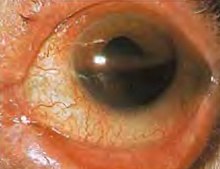User:Mr. Ibrahem/Hyphema
| Hyphema | |
|---|---|
| Other names | Hyphaema, anterior chamber hemorrhage |
 | |
| Hyphema - occupying half of anterior chamber of eye | |
| Specialty | Opthalmology |
| Symptoms | Blurry vision, pain with lights, visible blood[1] |
| Complications | Glaucoma, permanent vision loss[2] |
| Types | Grade 0 to IV[2] |
| Causes | Injury to the eye, spontaneously[2] |
| Risk factors | Leukemia, hemophilia, von Willebrand disease, sickle cell disease, diabetes, anticoagulants[2] |
| Diagnostic method | Examination[3] |
| Differential diagnosis | Open globe, vitreous bleed, corneal abrasion, iritis[3] |
| Treatment | Raised head of bed, pain medication, ophthalmology follow-up[2] |
| Frequency | 12 per 100,000 per year[2] |
Hyphema is when blood enters the front (anterior) chamber of the eye, the area between the iris and the cornea.[4] Symptoms often include blurry vision and pain with bright light.[1] A layer of blood may be seen in the lower part of the eye when a person is standing.[1] Complications may include glaucoma and permanent vision loss.[2]
It most commonly occurs due to a direct injury to the eye; though may occasionally occur spontaneously.[2] Common types of direct injury including getting hit by a ball in sports and assault.[2] Risk factors include leukemia, hemophilia, von Willebrand disease, sickle cell disease, diabetes, and being on anticoagulant medication.[2] The underlying mechanism involves bleeding from the ciliary body or iris.[2] Diagnosis is based on examination, including by slit lamp.[3]
Management involves raising the head of the bed more than 30 degrees, including during sleep, an eye shield, and close follow up by an ophthalmologist.[2] Medication to manage pain and nausea may also be required.[2] This may include cyclopentolate eye drops to prevent the pupil from moving, as long as the intraocular pressure is normal.[2] Bleeding disorder may also require treatment.[2] For those with high intraocular pressures or who are not improving, surgery may be recommended.[2]
Most people, especially those with smaller bleeds, recover fully.[2] In those with less than 33% involvement recovery is about 90%, while this decreases to about 50 to 75% when the entire anterior chamber is full of blood.[2] Hyphema affects about 12 per 100,000 per year.[2] Most cases (about 70%) occur in children.[2] Males are affected more commonly than females.[2]
References[edit]
- ^ a b c "Hyphema - Injuries and Poisoning". Merck Manuals Consumer Version. Archived from the original on 27 June 2022. Retrieved 5 July 2022.
- ^ a b c d e f g h i j k l m n o p q r s t u Gragg, J; Blair, K; Baker, MB (January 2022). "Hyphema". PMID 29939579.
{{cite journal}}: Cite journal requires|journal=(help) - ^ a b c DFAAPA, James Van Rhee, MS, PA-C.; DFAAPA, Christine Bruce, DMSc, MHSA, PA-C.; PA-C, Stephanie Neary, MPA, MMS (5 February 2022). Clinical Medicine for Physician Assistants. Springer Publishing Company. p. 76. ISBN 978-0-8261-8243-2. Archived from the original on 10 July 2022. Retrieved 5 July 2022.
{{cite book}}: CS1 maint: multiple names: authors list (link) - ^ Gharaibeh, Almutez; Savage, Howard I.; Scherer, Roberta W.; Goldberg, Morton F.; Lindsley, Kristina (2019). "Medical interventions for traumatic hyphema". The Cochrane Database of Systematic Reviews. 1: CD005431. doi:10.1002/14651858.CD005431.pub4. ISSN 1469-493X. PMC 6353164. PMID 30640411.
